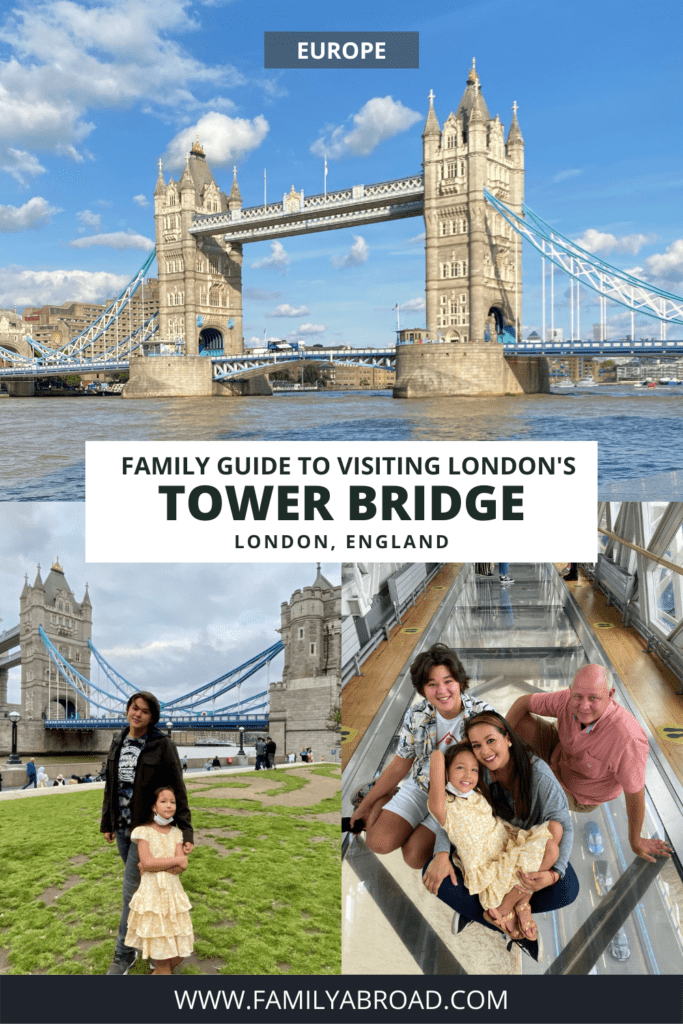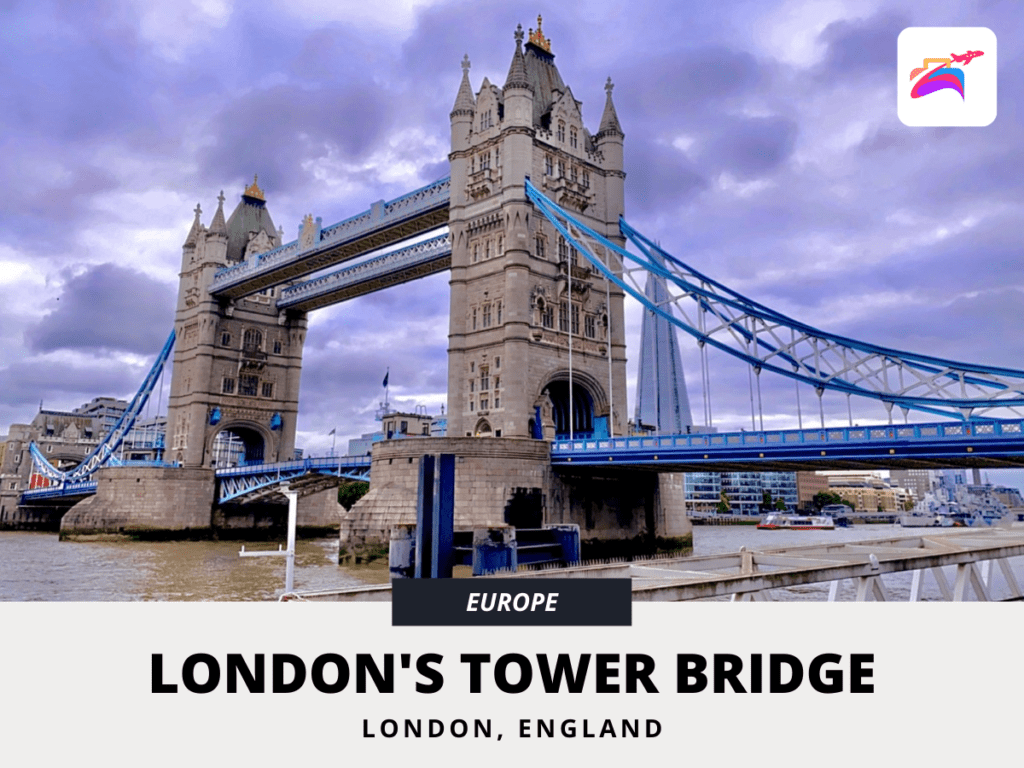Overview
Many people confuse Tower Bridge with its neighbor, London Bridge. They think they are visiting one bridge, when, in fact, they are in visiting the other. These are two different bridges. Although the London Bridge is a nice bridge with storied references to the children’s game of “London Bridges Falling Down” (see Bethany’s blog post), the iconic bridge in front of the Tower of London is the bridge you are probably looking for. It was our next adventure and we were not disappointed.
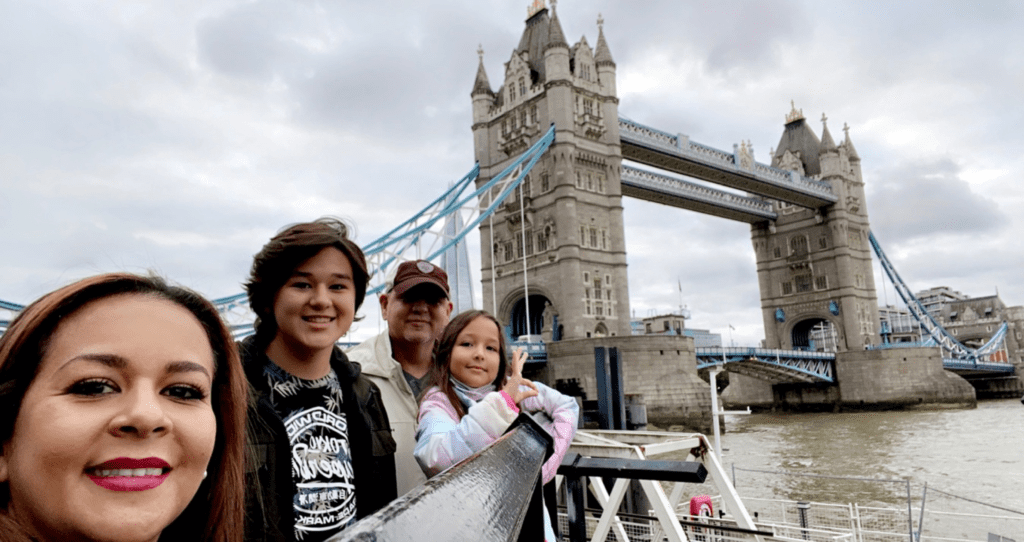
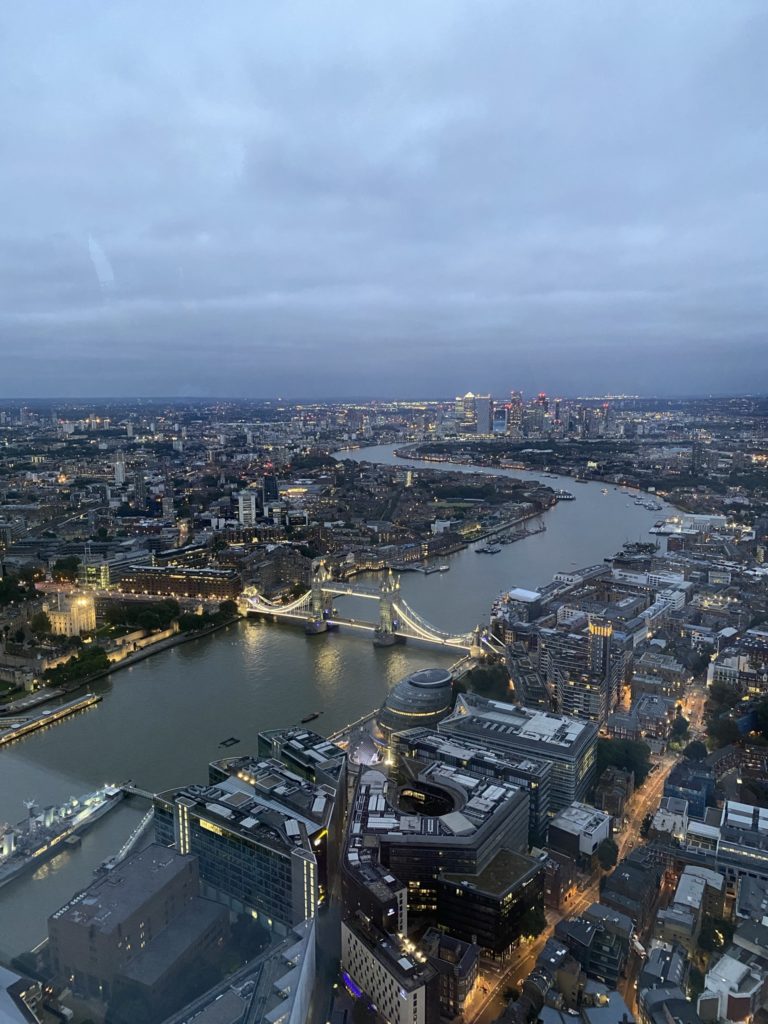
The Build
It was in 1876 they decided that another bridge was needed due to the growth of London. A call for designs and ideas for a new bridge in the east of London was made. It was to be built directly down the waterway from the London Bridge. It was going to be a huge undertaking because the bridge had to be built in such a way that the ships trafficking the Thames River had to be undisturbed.
50 designs were submitted in the competition to be the architect chosen to build this future icon. And in October of 1884, the design of architect Sir Horace Jones was selected. As our family walked across the Tower Bridge looking out over the great Thames River, we admired the panoramic views of the City of London. We later learned that the founding architect never had the opportunity to see his work of art in its full glory as he passed away shortly before his achievement was completed.
It is easy to forget how much goes into the actual creation and making of such a landmark. This was a major undertaking, with the planning phase alone taking two years to complete. The dangerous construction phase then started with the help of 432 construction workers.
Construction efforts of the state-of-the-art steel bridge finally finished in 1894. In fact, it required 11,000 tons of steel just to create the framework. Here, we blissfully stood on this magnificent structure where the Prince and Princess of Wales once graced this landmark back on June 30, 1894.
Standing 213 feet tall with two intricately gothic-looking towers, it has a distinguishable and mighty presence at 800 feet long. It was designed to look a lot older than its actual age. It was all part of a coordinated effort to make the bridge flow well with the historic city and with its neighboring bridges. Cornish granite and Portland stone make up its appearance, once being a brownish chocolate color which you can still see on the banisters inside. More recently it received a bit of a makeover in celebration of the Queen’s Silver Jubilee transforming it with colors of red, white, and blue.
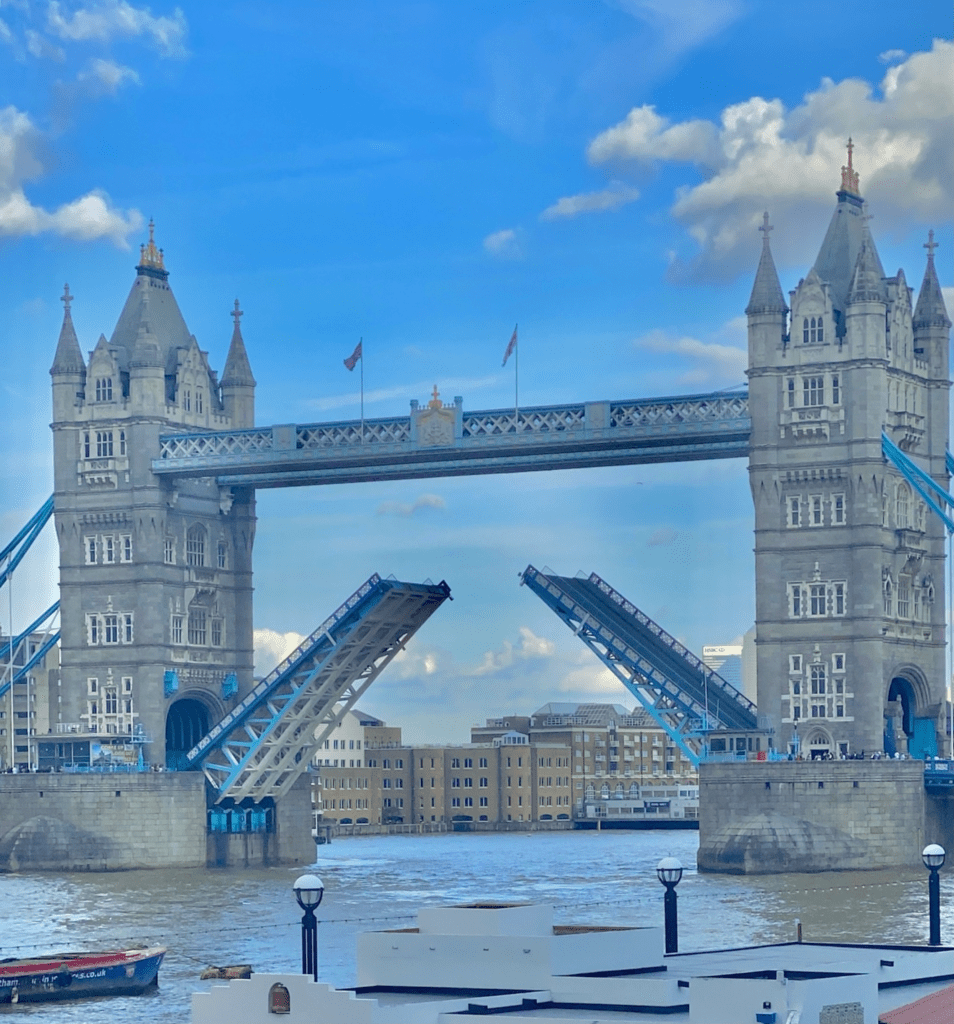
Not a Draw Bridge (and how to see it open)
Technically, it is not a drawbridge because its roads are too heavy for ropes and chains to pull up the bridges. Instead, it is a bascule bridge, where the roads act like giant see-saws, pivoting to open and close.
Tower Bridge is one of almost 400 in the entire world and it is probably the most famous moveable bridge in the world. This was one of the countless reasons why we made it an important part of our London family trips! To see the seesaw actions of the bridge created an amazing opportunity for the children to witness and learn about engineering.
The Tower Bridge lifts by means of hydraulics. Once by steam, it is now powered by oil and electricity when allowing waterway traffic to clear through. Tower Bridge’s website even lets you look ahead so you can see when the bridge will be lifting . We used this website and actually witnessed the bridge opening and closing two different times. It only opens and closes when absolutely necessary, so it is worth planning this event into your day.
It is hypnotizing and remarkable to watch as it raises to allow paddle steamers, sailing barges, commercial ships and grand cruise ships to pass safely under the historic Tower Bridge passageway. About 800 different types of vessels clear through the world-famous lift each year. Even a royal yacht has sailed through the Tower Bridge with the Queen and her family aboard. The Royal Yacht Britannia sailed across the Thames River in 1954 under the Tower Bridge and was greeted by eager onlookers lining the banks to see royalty travel in such proximity.
The Bus that Jumped the Thames River and Other Strange (but true) Stories!
The Bus
Vehicular traffic flows constantly over Tower Bridge as it sprawls over the River Thames in the heart of London between the boroughs of Tower Hamlets and Southwark. In the days of the past, a warning bell was to be rung letting you know the bridge would be opening and not to pass. Well, on December 30, 1952, Arthur Gunter was chauffeuring bus # 78 when the watchmen may have forgotten to do this one important requirement. Therefore, the driver found himself in a bit of a predicament as he and his passengers were being raised onto the bascule as the Tower Bridge began to open. In a Hollywood-like action movie stunt, the bus accelerated to jump onto the other side that was still lowered. Although Albert got the bus and the passengers to safety, he suffered a broken leg. For his courageous action, he was honored with 1 day off of work and £10 (just under $400 in today’s economy).
One Boat Crashed into the Bridge 3 Times! Ouch!
However, not all ships sail through smoothly! In fact, there have been several ships that have hit the bridge and even one ship, in particular, that ran into it 3 different times over a 10 year period! It was a Spanish cargo vessel named the Urquiola. On one such crash, the Urquiola didn’t have the right trajectory, causing it to crash into the Tower Bridge. Some of the stonework on the bridge ended up in the river and it caused the bridge to have to briefly close. In normal English fashion, the police simply stated that “they [Urquiola] are starting to make a habit about it.”
The Bet that Led a Plane to Fly Over the Bridge
In 1951, a 13 year old son bet his father the sum of $35 shillings that the father could not fly his plane over the Tower Bridge. Surprisingly, the father accepted the bet and he successfully flew his plane down the Thames River and directly over the bascules. While it is unknown if he actually collected on the $35 shilling wager, it is a fact that he was fined £100 pounds!
The Glass Floor, Two Towers and Mechanical Room
After spending some time exploring the grounds of the Tower Bridge, we made our way (up a lot of stairs) to the Exhibition starting at the North Tower. The Tower Bridge exhibition is full of facts, displays, and videos of information to learn firsthand how it all came to be. Taking you back in time to when it all started to come together.
Crossing along the East Walkway and West Walkway, we headed to the iconic and mesmerizing Glass Floor. But first, we couldn’t pass by the glass windows with the panoramic views of London and its skyline, stopping to look out to see all that was out there.

FAMILY TIP: The Tower Bridge has a lot of fun activities for children. From this viewpoint, there is an organized game of “Eye-Spy” for children as they try to locate and identify many of the iconic buildings on the London Skyline. Just ask one of the staff for more information.
As we made our way upon the glass floor, it took a bit of bravery to stand upon it and have the nerve to open our eyes. Its strength could hold us since it can hold up to four of London’s classic black cabs, but you still feel the butterflies in your stomach swirling around. 42 meters below was the River Thames as we watched the flowing traffic cross the Tower Bridge – giving us a bird’s eye view of the daily life of London’s people. Dizzying, exhilarating, a bit of thrill and excitement, we all took a turn staring down to the scene below.
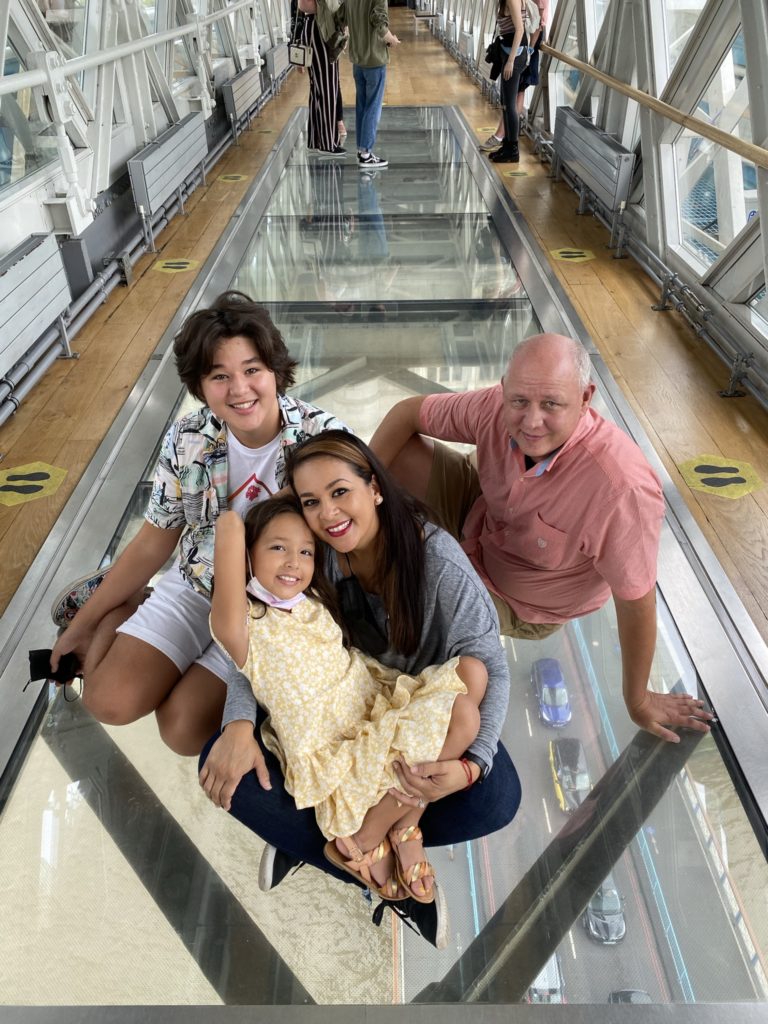
Next we went back down the South Tower, following the blue line marking the path so we kept on track. The painted blue line is commemorating all the workers that made Tower Bridge what it is today. The last part of the Tower Bridge Exhibition (and separate from the actual Tower Bridge) is the Victorian Engine Rooms at the river level. With displays of original engines and plenty of interactive information, it was a great way to end the tour. Bethany thought that the colorful and powerful machines that powered the bridge in the past looked a bit like the (scary) boat in Willy Wonka and the Chocolate Factory. Look at the picture and make your own decision!

FAMILY TIP: Be sure to download the app that allows your children to use a phone as a working wrench to tighten “loose” bolts, to shovel coal into the boilder and to steer their ship to safety!
Things to know before visiting
ENTRY
For entry to Tower Bridge, you can purchase tickets online by selecting your date and entry time. Adult tickets are £10.60 giving you access to the towers, walkways, glass floors, and engine room. A child’s ticket (aged 5-15) is £ 5.30 and under 5 years are granted free entry.
There are family packages as well offered to buy your group tickets. They are non-refundable so be sure to be there for your designated booking time. Be sure to check the official website to make sure ticket prices and hours of operation are correct.
OPENING HOURS
It is open daily from 9:30AM – 6PM. The last entry is at 5PM.
HOW LONG DO I NEED TO SPEND AT TOWER BRIDGE?
It will take you 1 hour to explore Tower Bridge.
WHEN IS THE BEST TIME TO VISIT TOWER BRIDGE?
To avoid crowds, we recommend visiting Tower Bridge during early mornings or late afternoons.
WATCH THE FULL VIDEO HERE
Like this post? Pin it on Pinterest!
